EVPN for VXLAN tunnels (Layer 3)
This chapter describes the components of EVPN-VXLAN Layer 3 on SR Linux.
EVPN L3 basic configuration
The basic EVPN Layer 3 configuration model builds on the model for EVPN routes described in EVPN for VXLAN tunnels (Layer 2), extending it with an additional route type to support inter-subnet forwarding: EVPN IP prefix route (or type 5, RT5).
The EVPN IP prefix route conveys IP prefixes of any length and family that need to be installed in the ip-vrfs of remote leaf nodes. The EVPN Layer 3 configuration model has two modes of operation:
Asymmetric IRB
This is a basic mode of operation EVPN L3 using IRB interfaces. The term ‟asymmetric” refers to how there are more lookups performed at the ingress leaf than at the egress leaf (as opposed to ‟symmetric”, which implies the same number of lookups at ingress and egress).
While the asymmetric model allows inter-subnet-forwarding in EVPN-VXLAN networks in a very simple way, it requires the instantiation of all the mac-vrfs of all the tenant subnets on all the leafs attached to the tenant. Because all the mac-vrfs of the tenant are instantiated, FDB and ARP entries are consumed for all the hosts in all the leafs of the tenant.
These scale implications may make the symmetric model a better choice for data center deployment.
Symmetric IRB
The term ‟symmetric” refers to how MAC and IP lookups are needed at ingress, and MAC and IP lookups are performed at egress.
SR Linux support for symmetric IRB includes the prefix routing model using RT5s as in draft-ietf-bess-evpn-prefix-advertisement, including the interface-less ip-vrf-to-ip-vrf model (IFL model) :
Compared to the asymmetric model, the symmetric model scales better because hosts’ ARP and FDB entries are installed only on the directly attached leafs and not on all the leafs of the tenant.
The following sections illustrate asymmetric and symmetric interface-less forwarding configurations.
Asymmetric IRB
The asymmetric IRB model is the basic Layer 3 forwarding model when the ip-vrf (or default network-instance) interfaces are all IRB-based. The asymmetric model assumes that all the subnets of a tenant are local in the ip-vrf/default route table, so there is no need to advertise EVPN RT5 routes.
EVPN-VXLAN L3 asymmetric forwarding illustrates the asymmetric IRB model.
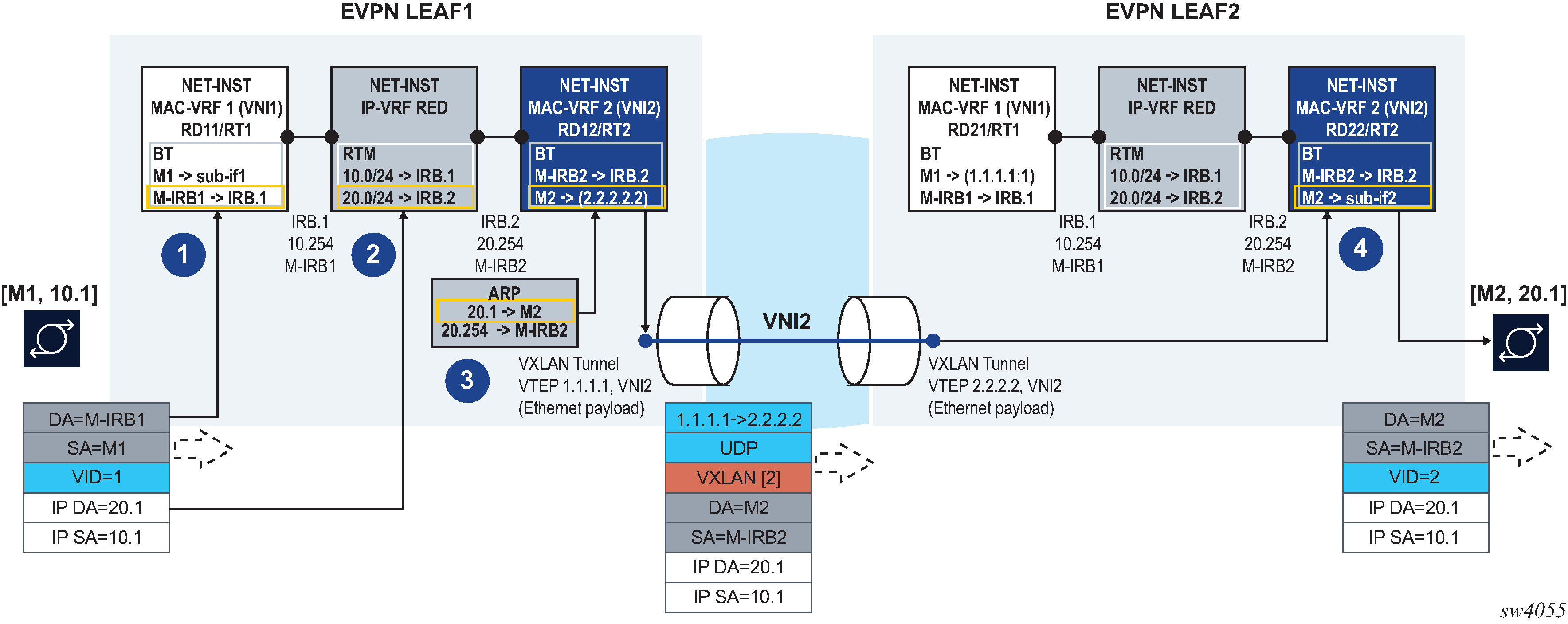
In this example, the host with IP address 10.1 (abbreviation of 10.0.0.1) sends a unicast packet with destination 20.1 (a host in a different subnet and remote leaf). Because the IP destination address (DA) is in a remote subnet, the MAC DA is resolved to the local default gateway MAC, M-IRB1. The frame is classified for MAC lookup on mac-vrf 1, and the result is IRB.1, which indicates that an IP DA lookup is required in ip-vrf red.
An IP DA longest-prefix match in the route table yields IRB.2, a local IRB interface, so an ARP and MAC DA lookup are required in the corresponding IRB interface and mac-vrf bridge table.
The ARP lookup yields M2 on mac-vrf 2, and the M2 lookup yields VXLAN destination [VTEP:VNI]=[2.2.2.2:2]. The routed packet is encapsulated with the corresponding inner MAC header and VXLAN encapsulation before being sent to the wire.
In the asymmetric IRB model, if the ingress leaf routes the traffic via the IRB to a local subnet, and the destination MAC is aliased to multiple leaf nodes in the same ES destination, SR Linux can do load balancing on a per-flow basis.
EVPN Leaf 1 in EVPN-VXLAN L3 asymmetric forwarding has the following configuration:
--{ [FACTORY] + candidate shared default }--[ ]--
interface ethernet-1/2 {
admin-state enable
vlan-tagging true
subinterface 1 {
type bridged
admin-state enable
vlan {
encap {
single-tagged {
vlan-id 1
}
}
}
}
}
interface irb0 {
subinterface 1 {
ipv4 {
address 10.0.0.254/24 {
anycast-gw true
}
}
anycast-gw {
}
}
subinterface 2 {
ipv4 {
address 20.0.0.254/24 {
anycast-gw true
}
}
anycast-gw {
}
}
}
network-instance ip-vrf-red {
type ip-vrf
interface irb0.1 {
}
interface irb0.2 {
}
}
network-instance mac-vrf-1 {
type mac-vrf
admin-state enable
interface ethernet-1/2.1 {
}
interface irb0.1 {
}
vxlan-interface vxlan1.1 {
}
protocols {
bgp-evpn {
bgp-instance 1 {
admin-state enable
vxlan-interface vxlan1.1
evi 1
}
}
bgp-vpn {
}
}
}
network-instance mac-vrf-2 {
type mac-vrf
admin-state enable
interface irb0.2 {
}
vxlan-interface vxlan1.2 {
}
protocols {
bgp-evpn {
bgp-instance 1 {
admin-state enable
vxlan-interface vxlan1.2
evi 2
}
}
bgp-vpn {
}
}
}
tunnel-interface vxlan1 {
vxlan-interface 1 {
type bridged
ingress {
vni 1
}
}
vxlan-interface 2 {
type bridged
ingress {
vni 2
}
}
}
EVPN Leaf 2 in EVPN-VXLAN L3 asymmetric forwarding has the following configuration:
--{ [FACTORY] + candidate shared default }--[ ]--
A:LEAF2# info
interface ethernet-1/12 {
admin-state enable
vlan-tagging true
subinterface 1 {
type bridged
admin-state enable
vlan {
encap {
single-tagged {
vlan-id 2
}
}
}
}
}
interface irb0 {
subinterface 1 {
ipv4 {
address 10.0.0.254/24 {
anycast-gw true
}
}
anycast-gw {
}
}
subinterface 2 {
ipv4 {
address 20.0.0.254/24 {
anycast-gw true
}
}
anycast-gw {
}
}
}
network-instance ip-vrf-red {
type ip-vrf
interface irb0.1 {
}
interface irb0.2 {
}
}
network-instance mac-vrf-1 {
type mac-vrf
admin-state enable
interface irb0.1 {
}
vxlan-interface vxlan1.1 {
}
protocols {
bgp-evpn {
bgp-instance 1 {
admin-state enable
vxlan-interface vxlan1.1
evi 1
}
}
bgp-vpn {
}
}
}
network-instance mac-vrf-2 {
type mac-vrf
admin-state enable
interface irb0.2 {
}
vxlan-interface vxlan1.2 {
}
protocols {
bgp-evpn {
bgp-instance 1 {
admin-state enable
vxlan-interface vxlan1.2
evi 2
}
}
bgp-vpn {
}
}
}
tunnel-interface vxlan1 {
vxlan-interface 1 {
type bridged
ingress {
vni 1
}
}
vxlan-interface 2 {
type bridged
ingress {
vni 2
}
}
}
Symmetric IRB interface-less IP-VRF-to-IP-VRF model
SR Linux support for symmetric IRB is based on the prefix routing model using RT5s, and implements the EVPN interface-less (EVPN IFL) ip-vrf-to-ip-vrf model.
In the EVPN IFL model, all interface and local routes (static, ARP-ND, BGP, and so on) are automatically advertised in RT5s without the need for any export policy. Interface host and broadcast addresses are not advertised. On the ingress PE, RT5s are installed in the route table as indirect with owner ‟bgp-evpn”.
EVPN-VXLAN L3 symmetric forwarding illustrates the forwarding for symmetric IRB.
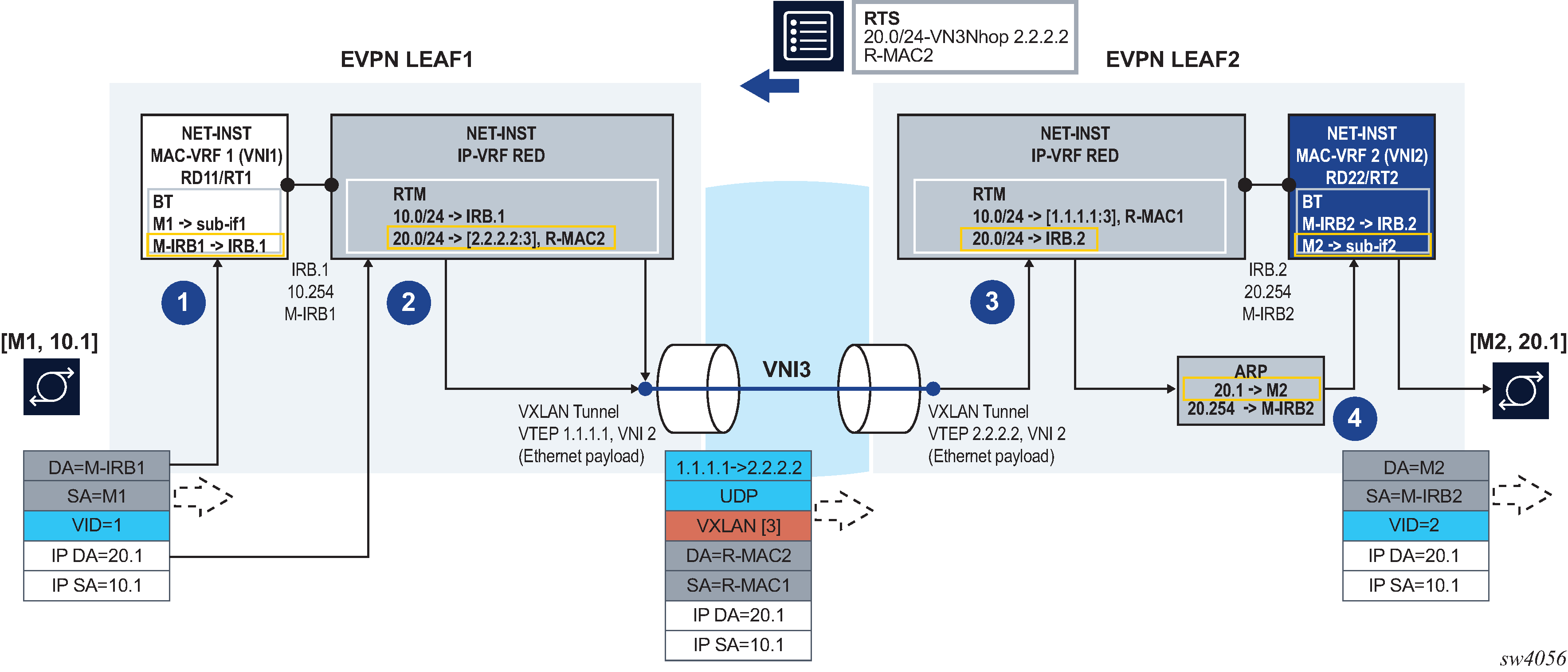
As in the asymmetric model, the frame is classified for bridge-table lookup on the mac-vrf and processed for routing in ip-vrf red.
In contrast to the asymmetric model, a longest prefix match does not yield a local subnet, but a remote subnet reachable via [VTEP:VNI]=[2.2.2.2:3] and inner MAC DA R-MAC2. SR Linux supports the EVPN interface-less (EVPN IFL) model, so that information is found in the ip-vrf route-table directly; a route lookup on the ip-vrf-red route-table yields a VXLAN tunnel and VNI.
Packets are encapsulated with an inner Ethernet header and the VXLAN tunnel encapsulation.
The inner Ethernet header uses the system-mac as MAC source address (SA), and the MAC advertised along with the received RT5 as MAC DA. No VLAN tag is transmitted or received in this inner Ethernet header.
At the egress PE, the packet is classified for an IP lookup on the ip-vrf red (the inner Ethernet header is ignored).
The inner and outer IP headers are updated as follows:
The inner IP header TTL is decremented.
The outer IP header TTL is set to 255.
The outer DSCP value is marked as described in QoS for VXLAN tunnels.
No IP MTU check is performed before or after encapsulation.
Because SR Linux supports EVPN IFL, the IP lookup in the ip-vrf-red route-table yields a local IRB interface.
Subsequent ARP and MAC lookups provide the information to send the routed frame to subinterface 2.
EVPN Leaf 1 in EVPN-VXLAN L3 symmetric forwarding has the following configuration:
--{ [FACTORY] + candidate shared default }--[ ]--
interface ethernet-1/2 {
admin-state enable
vlan-tagging true
subinterface 1 {
type bridged
admin-state enable
vlan {
encap {
single-tagged {
vlan-id 1
}
}
}
}
}
interface irb0 {
subinterface 1 {
ipv4 {
address 10.0.0.254/24 {
anycast-gw true
}
}
anycast-gw {
}
}
}
network-instance ip-vrf-red {
type ip-vrf
interface irb0.1 {
}
vxlan-interface vxlan1.3 {
}
protocols {
bgp-evpn {
bgp-instance 1 {
admin-state enable
vxlan-interface vxlan1.3
evi 3
}
}
bgp-vpn {
}
}
}
network-instance mac-vrf-1 {
type mac-vrf
admin-state enable
interface ethernet-1/2.1 {
}
interface irb0.1 {
}
vxlan-interface vxlan1.1 {
}
protocols {
bgp-evpn {
bgp-instance 1 {
admin-state enable
vxlan-interface vxlan1.1
evi 1
}
}
bgp-vpn {
}
}
}
tunnel-interface vxlan1 {
vxlan-interface 1 {
type bridged
ingress {
vni 1
}
}
vxlan-interface 3 {
type routed
ingress {
vni 3
}
}
}
EVPN Leaf 2 in EVPN-VXLAN L3 symmetric forwarding has the following configuration:
--{ [FACTORY] + candidate shared default }--[ ]--
interface ethernet-1/12 {
admin-state enable
vlan-tagging true
subinterface 2 {
type bridged
admin-state enable
vlan {
encap {
single-tagged {
vlan-id 2
}
}
}
}
}
interface irb0 {
subinterface 2 {
ipv4 {
address 20.0.0.254/24 {
anycast-gw true
}
}
anycast-gw {
}
}
}
network-instance ip-vrf-red {
type ip-vrf
interface irb0.2 {
}
vxlan-interface vxlan1.3 {
}
protocols {
bgp-evpn {
bgp-instance 1 {
admin-state enable
vxlan-interface vxlan1.3
evi 3
}
}
bgp-vpn {
}
}
}
network-instance mac-vrf-2 {
type mac-vrf
admin-state enable
interface ethernet-1/12.2 {
}
interface irb0.2 {
}
vxlan-interface vxlan1.2 {
}
protocols {
bgp-evpn {
bgp-instance 1 {
admin-state enable
vxlan-interface vxlan1.2
evi 2
}
}
bgp-vpn {
}
}
}
tunnel-interface vxlan1 {
vxlan-interface 2 {
type bridged
ingress {
vni 2
}
}
vxlan-interface 3 {
type routed
ingress {
vni 3
}
}
}
Anycast gateways
Anycast gateways (anycast-GWs) are a common way to configure IRB subinterfaces in DC leaf nodes. Configuring anycast-GW IRB subinterfaces on all leaf nodes of the same BD avoids tromboning for upstream traffic from hosts moving between leaf nodes.
Anycast-GW IRB configuration shows an example anycast-GW IRB configuration.
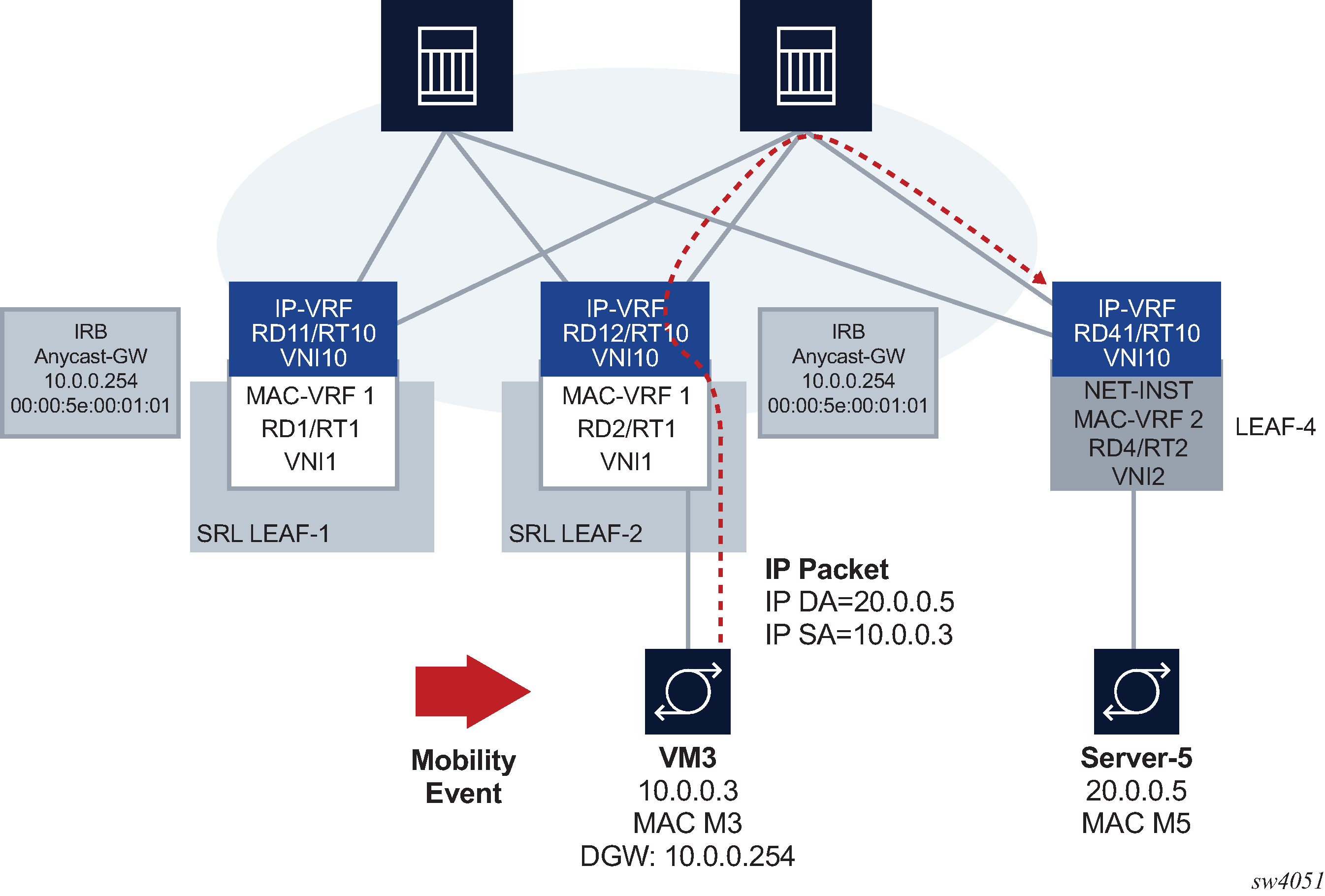
Anycast-GWs allow configuration of the same IP and MAC addresses on the IRB interfaces of all leaf switches attached to the same BD; for example, SRL LEAF-1 and SRL LEAF-2 in Anycast-GW IRB configuration above. This optimizes the south-north forwarding because a host’s default gateway always belongs to the connected leaf, irrespective of the host moving between leaf switches; for example VM3 moving from SRL LEAF-1 to SRL LEAF-2 in the figure.
When an IRB subinterface is configured as an anycast-GW, it must have one IP address configured as ‟anycast-gw”. The subinterface may or may not have other non-anycast-GW IP addresses configured.
To simplify provisioning, an option to automatically derive the anycast-gw MAC is supported, as described in draft-ietf-bess-evpn-inter-subnet-forwarding. The auto-derivation uses a virtual-router-id similar to MAC auto-derivation in RFC 5798 (VRRP). Anycast GWs use a default virtual-router-id of 01 (if not explicitly configured). Because only one anycast-gw-mac per IRB sub-interface is supported, the anycast-gwmac for IPv4 and IPv6 is the same in the IRB sub-interface.
The following is an example configuration for an anycast-GW subinterface:
// Configuration Example of an anycast-gw IRB sub-interface
[interface irb1 subinterface 1 ]
A:leaf-1/2# info
ipv4 {
address 10.0.0.254/24 {
primary true
anycast-gw true
}
}
anycast-gw {
virtual-router-id 2
}
// State Example of an anycast-gw IRB sub-interface
[interface irb1 subinterface 1 ]
A:leaf-1/2# info from state
ipv4 {
address 10.0.0.254/24 {
primary true
anycast-gw true
}
}
anycast-gw {
virtual-router-id 2
anycast-gw-mac 00:00:5e:00:01:02
anycast-gw-mac-origin auto-derived
}
The anycast-gw true command designates the associated IP address as an anycast-GW address of the subinterface and associates the IP address with the anycast-gw-mac address in the same sub-interface. ARP requests or Neighbor Solicitations received for the anycast-GW IP address are replied using the anycast-gw-mac address, as opposed to the regular system-derived MAC address. Similarly, CPM-originated GARPs or unsolicited neighbor advertisements sent for the anycast-gw IP address use the anycast-gw-mac address as well. Packets routed to the IRB use the anycast-gw-mac as the SA in Ethernet header.
All IP addresses of the IRB subinterface and their associated MACs are advertised in MAC/IP routes with the static flag set. The non-anycast-gw IPs are advertised along with the interface hardware MAC address, and the anycast-gw IP addresses along with the anycast-gw-mac address.
In addition, the anycast-gw true command makes the system skip the ARP/ND duplicate-address-detection procedures for the anycast-GW IP address.
EVPN L3 multi-homing and anycast gateways
In an EVPN L3 scenario, all IRB interfaces facing the hosts must have the same IP address and MAC; that is, an anycast-GW configuration. This avoids inefficiencies for all-active multi-homing or speeds up convergence for host mobility.
The use of anycast-GW along with all-active multi-homing is illustrated in EVPN-VXLAN L3 model – multi-homing and anycast gateway.
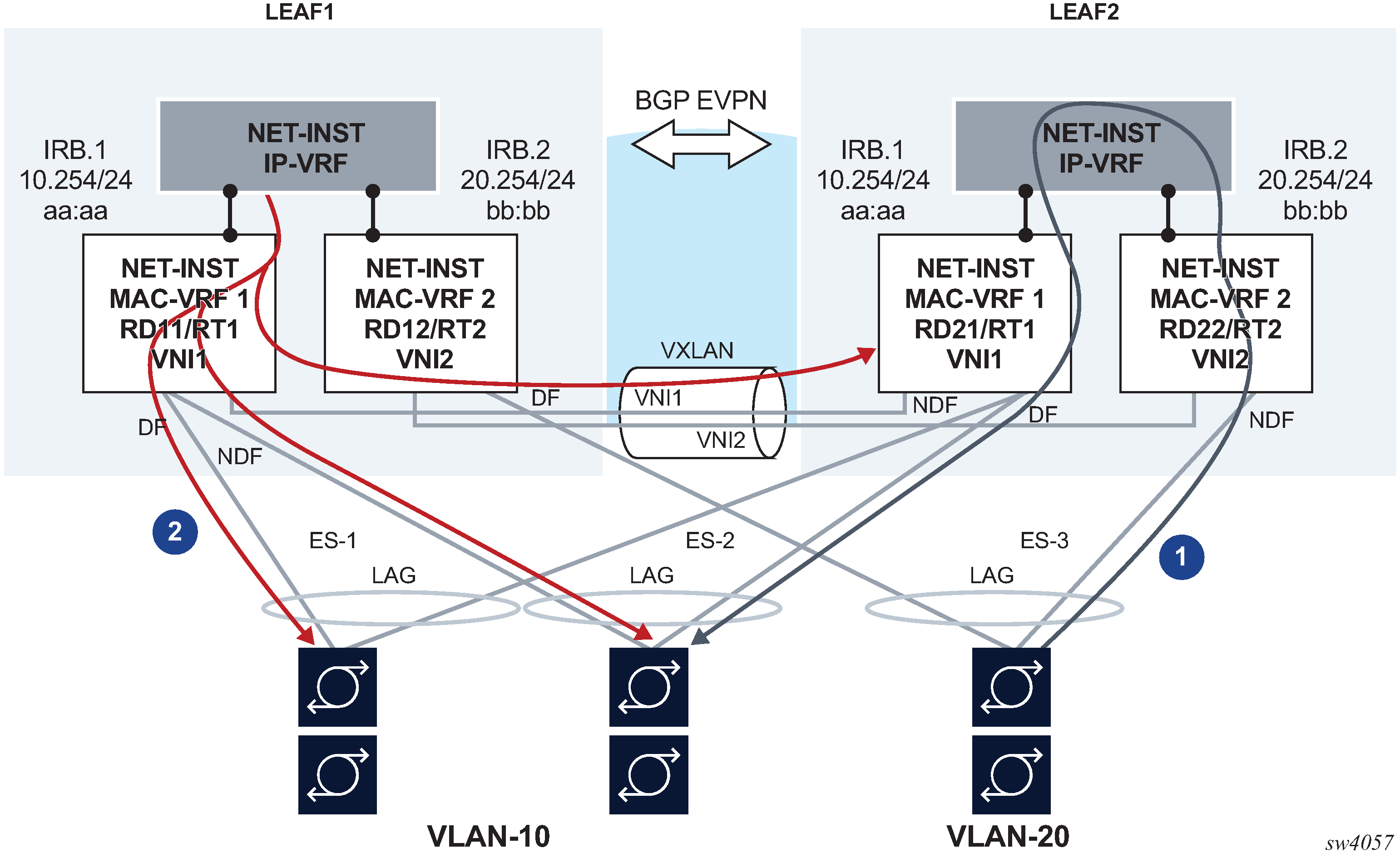
In this example:
Routed unicast traffic is always routed to the directly connected leaf (no tromboning).
BUM traffic sent from the IRB interface is sent to all DF and NDF subinterfaces (similar to BUM entering a subinterface).
This applies to:
System-generated unknown or bcast
ARP requests and GARPs
Unicast with unknown MAC DA
When a host connected to ES-3 sends a unicast flow to be routed in the ip-vrf, the flow must be routed in the leaf receiving the traffic, irrespective of the server hashing the flow to Leaf-1 or Leaf-2. To do this, the host is configured with only one default gateway, 20.254/24. When the host ARPs for it, it does not matter if the ARP request is sent to Leaf-1 or Leaf-2. Either leaf replies with the same anycast-GW MAC, and when receiving the traffic either leaf can route the packet.
This scenario is supported on ip-vrf network-instances and the default network-instance.
When IRB subinterfaces are attached to MAC-VRF network-instances with all-active multi-homing Ethernet Segments, the arp timeout / neighbor-discovery stale-time settings on the IRB subinterface should be set to a value that is 30 seconds lower than the age-time configured in the MAC-VRF. This avoids transient packet loss situations triggered by the MAC address of an active ARP/ND entry being removed from the MAC table.
EVPN L3 host route mobility
EVPN host route mobility refers to the procedures that allow the following:
Learning ARP/ND entries out of unsolicited messages from hosts
Generating host routes out of those ARP/ND entries
Refreshing the entries when mobility events occur within the same BD.
EVPN host route mobility is part of basic EVPN Layer 3 functionality as defined in draft-ietf-bess-evpn-inter-subnet-forwarding.
EVPN host route mobility illustrates EVPN host route mobility.
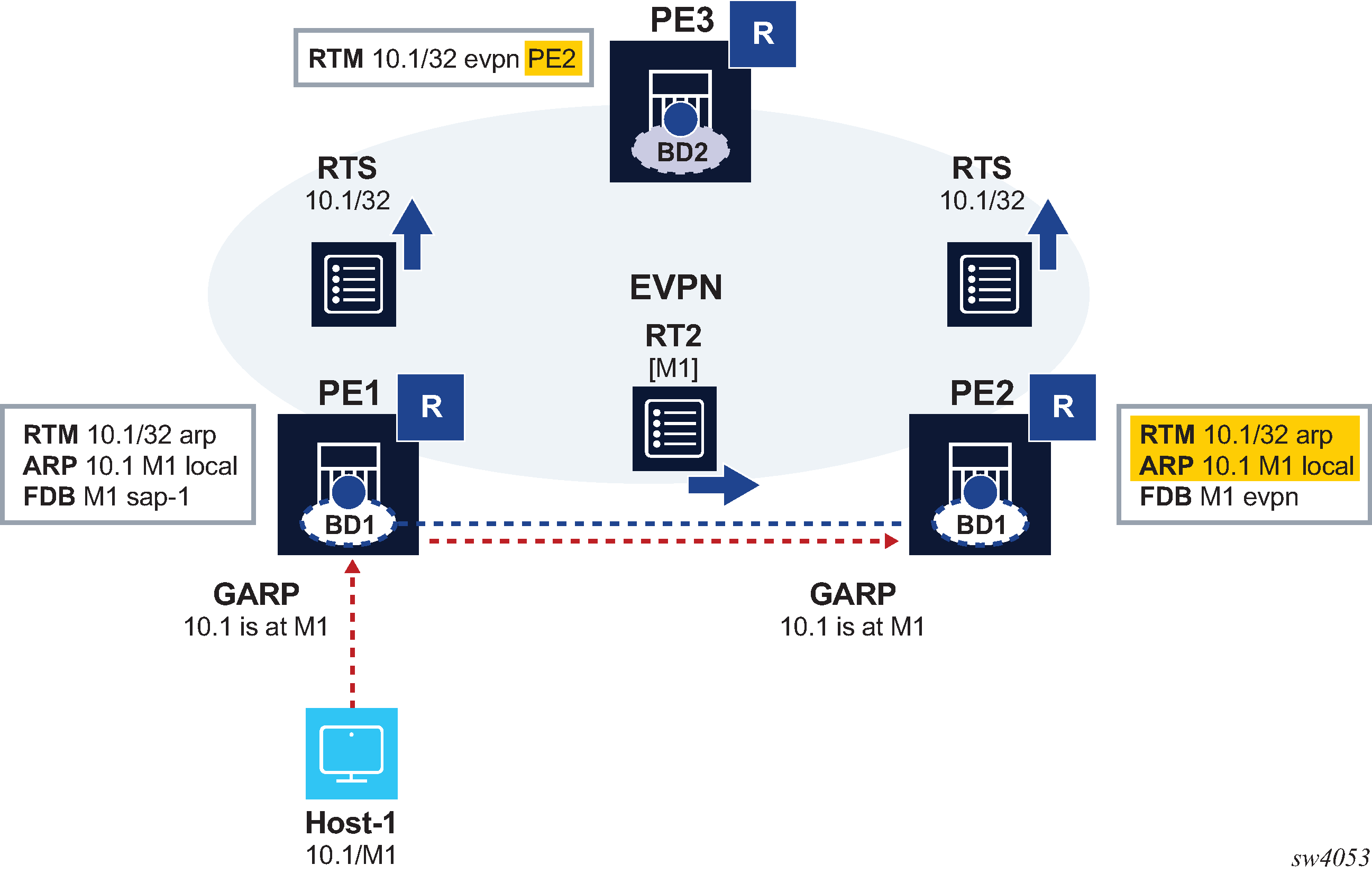
In EVPN host route mobility a host is attached to PE1, so all traffic from PE3 to that host must be forwarded directly to PE1. When the host moves to PE2, all the tables must be immediately updated so that PE3 sends the traffic to PE2. EVPN host route mobility works by doing the following:
Snooping and learning ARP/ND entries for hosts upon receiving unsolicited GARP or NA messages.
Creating host routes out of those dynamic ARP/ND entries. These routes only exist in the control plane and are not installed in the forwarding plane to avoid FIB exhaustion with too many /32 or /128 host routes.
Advertising the locally learned ARP/ND entries in MAC/IP routes so that ARP/ND caches can be synchronized across leaf nodes.
Advertising the host routes as IP prefix routes.
Triggering ARP/ND refresh messages for changes in the ARP/ND table or MAC table for a specific IP, which allows updating the tables without depending on the ARP/ND aging timers (which can be hours long).
The following configuration enables an anycast-GW IRB subinterface to support mobility procedures:
// Example of the configuration of host route mobility features
--{ candidate shared default }--[ interface irb1 subinterface 1 ]--
A:-# info
ipv4 {
address 10.0.0.254/24 {
anycast-gw true
primary
}
arp {
learn-unsolicited true
host-route {
populate static
populate dynamic
}
evpn {
advertise static
advertise dynamic
}
}
}
ipv6 {
address 200::254/64 {
anycast-gw true
primary
}
neighbor-discovery {
learn-unsolicited true
host-route {
populate static
populate dynamic
}
evpn {
advertise static
advertise dynamic
}
}
}
anycast-gw {
}
--{ candidate shared default }--[ interface irb1 subinterface 1 ]--
# info from state
admin-state enable
ip-mtu 1500
name irb1.1
ifindex 1082146818
oper-state up
last-change "a minute ago"
ipv4 {
allow-directed-broadcast false
address 10.0.0.254/24 {
anycast-gw true
origin static
}
arp {
duplicate-address-detection true
timeout 14400
learn-unsolicited true
host-route {
populate static
populate dynamic
}
}
}
}
ipv6 {
address 200::254/64 {
anycast-gw true
origin static
status unknown
}
address fe80::201:1ff:feff:42/64 {
origin link-layer
status unknown
}
neighbor-discovery {
duplicate-address-detection true
reachable-time 30
stale-time 14400
learn-unsolicited both
host-route {
populate static
populate dynamic
}
}
router-advertisement {
router-role {
current-hop-limit 64
managed-configuration-flag false
other-configuration-flag false
max-advertisement-interval 600
min-advertisement-interval 200
reachable-time 0
retransmit-time 0
router-lifetime 1800
}
}
}
anycast-gw {
virtual-router-id 1
anycast-gw-mac 00:00:5E:00:01:01
anycast-gw-mac-origin vrid-auto-derived
}
...
In this configuration, when learn-unsolicited is set to true, the node processes all solicited and unsolicited ARP/ND flooded messages received on subinterfaces (no VXLAN) and learns the corresponding ARP/ND entries as dynamic. By default, this setting is false, so only solicited entries are learned by default.
The advertisement of EVPN MAC/IP routes for the learned ARP entries must be enabled/disabled by configuration; it is disabled by default. In the example above, this is configured with the advertise dynamic and advertise static settings.
The creation of host routes in the ip-vrf route table out of the dynamic or static ARP entries
can be enabled/disabled by configuration; it is disabled by default. In the example
above, this is configured with the host-route populate dynamic and
host-route populate static settings.
The dynamic ARP entries are refreshed without any extra configuration. The system sends ARP requests for the dynamic entries to make sure the hosts are still alive and connected.
EVPN IFL interoperability with EVPN IFF
By default, the SR Linux EVPN IFL (interface-less) model, described in Symmetric IRB interface-less IP-VRF-to-IP-VRF model, does not interoperate with the EVPN IFF (interface-ful) model, as supported on Nuage WBX devices. However, it is possible to configure the SR Linux EVPN IFL model to interoperate with the EVPN IFF model.
To do this, configure the advertise-gateway-mac command for the ip-vrf network-instance. When this command is configured, the node advertises a MAC/IP route using the following:
The gateway-mac for the ip-vrf (that is, the system-mac)
The RD/RT, next-hop, and VNI of the ip-vrf where the command is configured
Null IP address, ESI or Ethernet Tag ID
Nuage WBX devices support two EVPN L3 IPv6 modes: IFF unnumbered and IFF numbered. The SR Linux interoperability mode enabled by the advertise-gateway-mac command only works with Nuage WBX devices that use the EVPN IFF unnumbered model. This is because the EVPN IFL and EVPN IFF unnumbered models both use the same format in the IP prefix route, and they differ only in the additional MAC/IP route for the gateway-mac. The EVPN IFL and EVPN IFF numbered models have different IP prefix route formats, so they cannot interoperate.
The following example enables interoperability with the Nuage EVPN IFF unnumbered model:
--{ [FACTORY] + candidate shared default }--[ ]--
# info from state network-instance protocols bgp-vpn
bgp-evpn {
bgp-instance 1 {
admin-state enable
vxlan-interface vxlan1.2
routes {
route-table {
mac-ip {
advertise-gateway-mac true
}
}
}
}
}
VIP discovery for redundant servers
In data centers, it is common to have clusters of servers sharing the same IP address and working in an active-standby mode, so that only one of the servers in the cluster is active at a time. This shared IP address is known as a virtual IP (VIP) address. SR Linux can discover which server in the cluster owns the VIP address.
ARP requests (NS for IPv6) from a leaf node or gratuitous ARP (unsolicited NA for IPv6) from a server are used to discover which host owns the VIP. Among the servers sharing the VIP, only the active one either sends a gratuitous ARP (or unsolicited NA) or replies to the ARP request (NS) from the leaf node. If a server does not send a gratuitous ARP, you can optionally configure SR Linux to send ARP requests periodically at a specified probe interval.
The leaf nodes create entries in their ARP tables that map the VIP to the MAC address of the active server. You can optionally configure a list of allowed MAC addresses so that the ARP/ND entry for the VIP is created only if the reply from the server comes from one of the MACs on the allowed list.
VIP discovery for the active server in a server group illustrates a configuration where three SR Linux devices in a MAC-VRF are connected to a redundant server group.
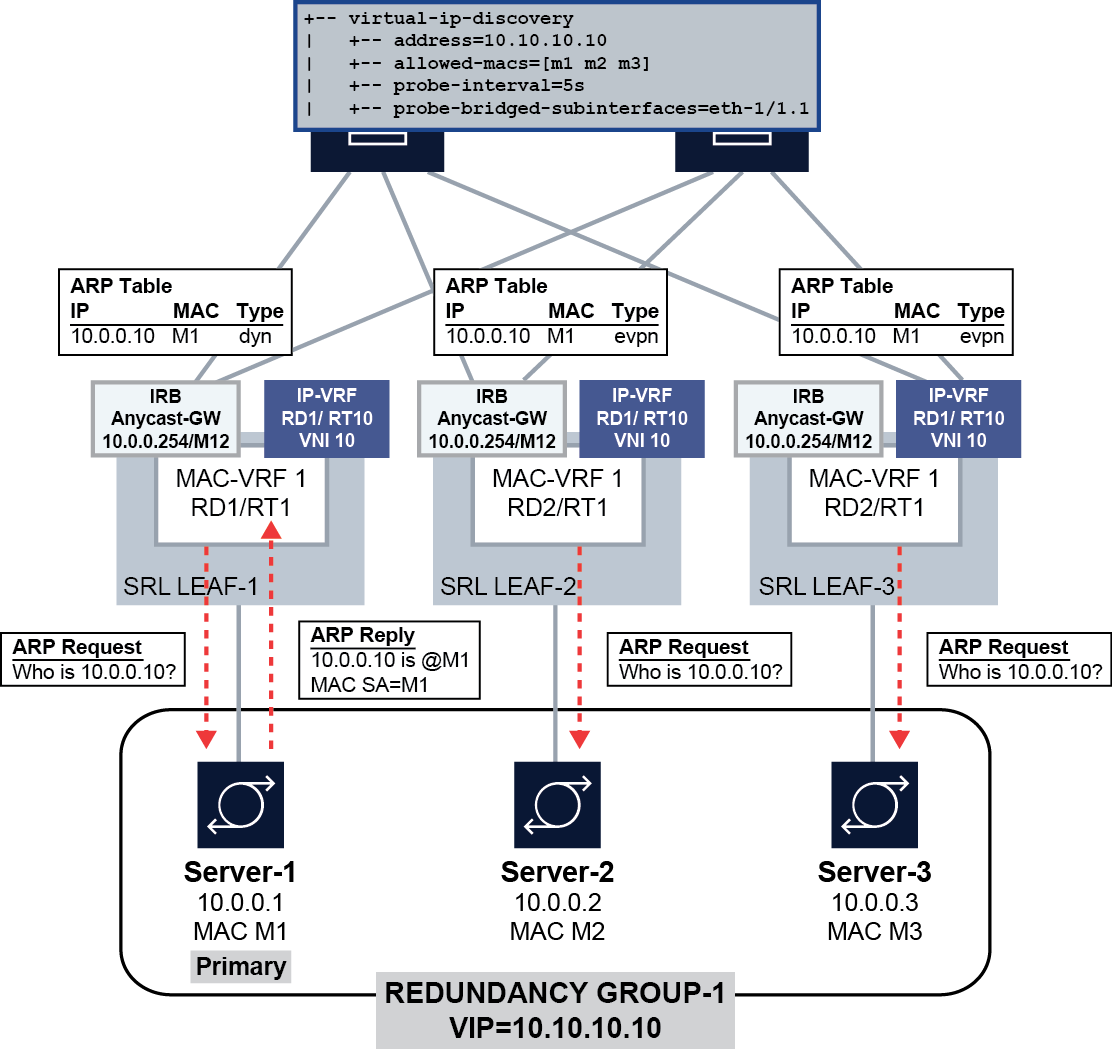
In this configuration, the SR Linux devices (SRL LEAF-1/2/3) start sending ARP requests for the VIP 10.10.10.10 on the ethernet 1/1.1 subinterface every 5 seconds until the ARP entry for the VIP/VMAC is learned. The ARP entry is created only if the MAC address matches one of the allowed MACs: M1, M2, or M3.
Initially Server-1 is the primary server in the server group, and it responds to the ARP request from Leaf-1, causing the server's MAC address M1 to be added to the ARP table on the SR Linux devices for VIP 10.10.10.10. If Server-2 (MAC M2) becomes the primary server, it sends out a gratuitous ARP message (or responds to an ARP request from LEAF-2), which triggers an update of the ARP table on Leaf-2 and a MAC/IP route update with 10.10.10.10/M2. When Leaf-1 receives the update, it updates its ARP table immediately with the new entry.
VIP discovery is supported on single-homed and multi-homed subinterfaces. For all-active multi-homing, and based on the local-bias behavior, the ARP/ND probes are sent to all ES subinterfaces irrespective of their DF state. When the active server replies, the MAC/IP route is synchronized in the other ES peers based on the functionality described in EVPN L3 host route mobility.
Configuring VIP discovery
To configure VIP discovery for an IRB interface, you specify the bridged subinterfaces that can be sent probe messages (ARP requests) for the VIP, optionally a probe interval that determines how often the probe messages are sent, and optionally a list of allowed MAC addresses that indicate the MAC addresses of the servers in the group.
The following example configures VIP discovery for IPv4:
--{ candidate shared default }--[ ]--
# info interface irb1 subinterface 1 ipv4 arp
interface irb1 {
subinterface 1 {
ipv4 {
arp {
virtual-ipv4-discovery {
address 10.10.10.10 {
probe-bridged-subinterfaces [
ethernet-1/1.1
]
probe-interval 5
allowed-macs [
00:14:9C:78:E2:E1
00:14:9C:78:E2:E2
00:14:9C:78:E2:E3
]
}
}
}
}
}
}The following example configures VIP discovery for IPv6:
--{ candidate shared default }--[ ]--
# info interface irb1 subinterface 1 ipv6 neighbor-discovery
interface irb1 {
subinterface 1 {
ipv6 {
neighbor-discovery {
virtual-ipv6-discovery {
address 2001::10:10:10:10 {
probe-interval 5
allowed-macs [
00:14:9C:78:E2:E1
00:14:9C:78:E2:E2
00:14:9C:78:E2:E3
]
probe-bridged-subinterfaces [
ethernet-1/1.1
]
}
}
}
}
}
}In this configuration, SR Linux starts sending ARP requests for VIP 10.10.10.10
(address parameter) on the ethernet 1/1.1
subinterface (probe-bridged-subinterfaces parameter) every 5
seconds (probe-interval parameter) so that the ARP entry for
the VIP/VMAC is learned. The ARP entry is created only if the MAC address matches
one of the MACs in the allowed list (allowed-macs
parameter).
Up to 10 subinterfaces can be specified in the probe-bridged-subinterfaces list. The probe messages are sent only to the subinterfaces in this list. If no subinterfaces are specified in the list, no probe messages are sent.
- The VIP is configured.
- When the IRB interface becomes operationally up (when the prefix becomes preferred).
- When the ARP/ND entry corresponding to the VIP moves from type dynamic to type EVPN, or from type dynamic to type dynamic (changing to a different MAC).
- When subinterfaces in the probe-bridged-subinterfaces list become operationally up.
- When the arpnd_mgr application restarts.
- When the allowed-macs list, probe-interval, or probe-bridged-subinterfaces list changes.
When the probe-interval is set to a non-zero value, SR Linux keeps probing for the VIP continuously, even after the ARP/ND entry for the VIP is created.
Up to 10 MAC addresses can be specified in the allowed-macs list. The ARP/ND entry for the VIP is created only if the resolving MAC address corresponds to one of the MAC addresses in the list. If no MAC addresses are specified in the list, any resolving MAC is valid for the creation of the ARP/ND entry. When a MAC address included in the allowed-macs list is used in an existing ARP/ND entry, and the MAC is removed from the list, the ARP/ND entry is deleted.
Displaying VIP discovery information
You can display the number of probe packets sent by the SR Linux device using the info from state command. Statistics are displayed for probe packets on individual VIPs and the total number of probe packets for all VIPs configured for the subinterface.
--{ candidate shared default }--[ ]--
# info from state interface irb1 subinterface 1 ipv4 arp
interface irb1 {
subinterface 1 {
ipv4 {
arp {
virtual-ipv4-discovery {
address 10.10.10.10 {
probe-bridged-subinterfaces [
ethernet-1/1.1
]
probe-interval 5
allowed-macs [
00:14:9C:78:E2:E1
00:14:9C:78:E2:E2
00:14:9C:78:E2:E3
]
statistics {
out-probe-packets 100
}
statistics {
out-total-probe-packets 100
}
}
}
}
}
}